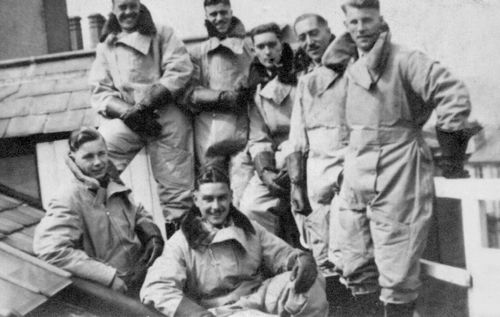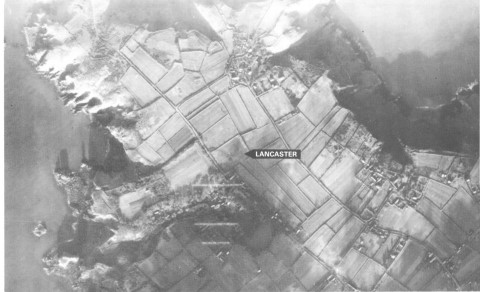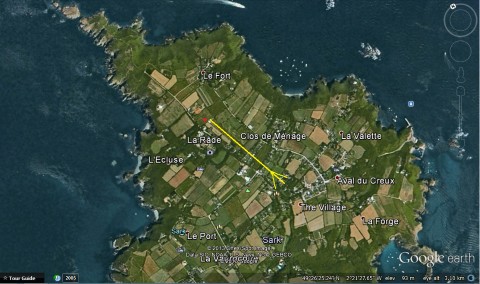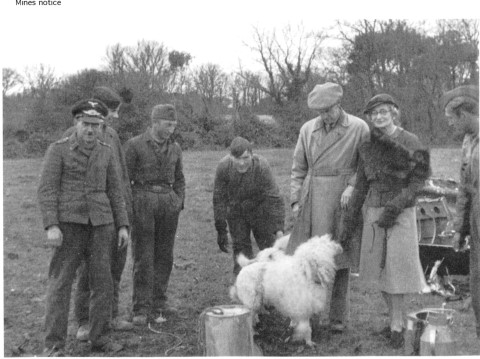Personnel Index - Detail

The Singleton crew, image courtesy of Charles Abate who comments......
"I have done some further digging and have found a photo of the complete crew of Lancaster W4107.
Unfortunately, I have only been able to identify David Hills in the photograph - stood at the far right."
Note: The Asociation believes that Sgt Pope is front centre.
22/23 November, 1942; STUTTGART:
Ground haze and thin cloud over Stuttgart prevented the Pathfinders from locating the centre of the city. With the help of a bright moon, the 7 Lancasters from 49 Squadron, did manage to pick up the river from the north and were able to gain good fixes. The Main Force arrived over Stuttgart just after 22.00hrs, and for the next hour over 200 bombers dropped their loads mainly in the south of the city.
At Scampton, 5 of the unit's Lancasters had returned safely. Eventually, it became apparent that Sgt Singleton and crew (W4107) had failed to return.
Some fifty years later, Eric Singleton recalls the reason why his Lancaster was prevented from returning to base:
"After dropping our bombs, unfortunately before getting clear, the aircraft was shot at, and received several direct hits. The starboard inner engine was on fire and there was fire in the fuselage... I thought we were going to have an explosion."
After a deterioration of the situation, four members of the crew baled out, but Sgt Singleton decided to see just how far he could continue to fly the damaged aircraft. The two remaining crew, mid upper gunner Eddie Pope and rear gunner Les Saunders, with great effort succeeded in extinguishing the fuselage fire, and miraculously, a short time later, the engine fire went out.
Eric continues: "We crossed the coast, and I thought we were North of the Cherbourg Peninsula en route for England. After a short time, seeing apparently 'friendly' land below us, I decided to bring the Lancaster down."
After a rather bumpy descent, skirting one field, shooting through a hedge before eventually coming to rest in a second field, Sgt Singleton and his intrepid gunners clambered out of the aircraft to find a reception party waiting.
Eric later proclaimed: "I thought it was the Home Guard, but as they asked us to put up our hands, we realised they were Germans!"
The Lancaster crew had erroneously landed on the Channel Island of Sark which was occupied by Germany during the Second World War, and as a result, Sgt Singleton and crew (including those who had baled out earlier) were to spend the rest of the war in POW camp. This 49 Squadron Lancaster was the only plane to land on the Island during the war, and the place in which it came down is still affectionately known by the islanders as 'Aeroplane Field'. Half a century later, Seigneur Beaumont, the Governor, invited Eric, and his wife Gwendolyn back to the island under much less hostile conditions. After a tour of the island by the traditional transport of horse and cart, the party visited the place where W4107 had 'landed'. But there was one more surprise to come... as they stood in the field, a lone Lancaster bomber (BBMF Flight) flew over... it was an extremely emotive moment.
Parts of the aircraft still remain in the field, and former Sgt Pilot Singleton was presented with a small piece, as a memento of both of his visits!
Sgt E.J. Singleton Pilot (P.o.W.)
Sgt R. Wood F/E (P.o.W.)
Sgt K.C. Corry NAV/B (P.o.W.)
Sgt A.G. McInnes W/AG (P.o.W.)
Sgt E. Pope A/G (P.o.W.)
Sgt D.J. Hills B/A (P.o.W.)
Sgt L.W. Saunders A/G (P.o.W.)
Crew on their 2nd operation'
Posted out' 1997

The photograph above is a routine PR (Photo Reconnaissance) sweep of the island two days after the crash.


Information and images received from Michael Lanyon and Penny Prevel:
In red I have marked the final landing position and in yellow the final approach, from the south to the north. With the information I now have it would seem the the pilot landed "wheels up" and skidded a distance of approx 500ft at which point the starboard wing punched holes into the hedge causing the port wing to drop thus turning the aircraft a sharp 90 degrees to port. We have taken measurements of the field used for the landing.........1000ft long and 85ft wide at the narrow end and 150ft at the widest. The pilot could not have touched down until roughly half way up the field where it is 102ft wide.
The photograph is of Sybil Hathaway Dame of Sark (Seigneur) with her second husband Bob, to her left. Also included are the German Occupation Forces together with wreckage of W4107 on the right.
Ian Le Gresley who is a retired Squadron Leader who flew Lancs post war gave us confirmation that W4107 did a wheels up landing.
Ian is a retired Squadron Leader living in Jersey. During WW2 I was a schoolboy on the Island during the German Occupation and my interest in aviation was ignited by much activity.
Post war I joined the Service through Cranwell and served for twenty years.
Shortly after the Occupation ended I visited Sark and the crash site of Lancaster W4107 and removed a number of items from what remained , mainly undercarriage struts ( showing flak damage) together with other small parts, and carried them (heavy!!) on the ferry back to Jersey.
It is interesting to note that one of the two sections of undercarriage strut I have shows the retraction strut linking mechanism retracted; this retraction will have taken place for the last time on take off at Scampton on that November day in 1942.
